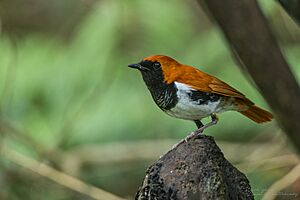Ryukyu robin facts for kids
Quick facts for kids Ryukyu robin |
|
|---|---|
 |
|
| Conservation status | |
| Scientific classification | |
| Genus: |
Larvivora
|
| Species: |
komadori
|
| Synonyms | |
|
Erithacus komadori |
|
The Ryukyu robin (Larvivora komadori) is a special bird found only in the Ryūkyū Islands of Japan. When we say a bird is endemic, it means it lives naturally in just one specific place and nowhere else in the world. This beautiful robin is a unique part of the wildlife in these Japanese islands.
For a while, another bird called the Okinawa robin (Larvivora namiyei) was thought to be a type of Ryukyu robin. However, scientists later decided it was its own distinct species.
Contents
Discovering the Ryukyu Robin
The Ryukyu robin is a fascinating bird that captures the attention of birdwatchers and scientists alike. Its scientific name, Larvivora komadori, helps scientists around the world know exactly which bird they are talking about.
Where Does the Ryukyu Robin Live?
The Ryukyu Islands are a chain of islands in Japan, stretching southwest from Kyushu to Taiwan. These islands have a warm, subtropical climate, which creates a perfect home for many unique plants and animals, including the Ryukyu robin. This bird thrives in the forests and woodlands found across these islands.
What's in a Name? Understanding Komadori
The specific part of the Ryukyu robin's scientific name, komadori, can be a little confusing! In Japanese, "komadori" is actually the common name for a different bird, the Japanese robin. It's like having two different people named "Robin" in English, but one is a first name and the other is a last name. For the Ryukyu robin, komadori is part of its scientific identity, even though it's also used for its relative.
The Ryukyu Robin's Family Tree: A Scientific Journey
Understanding how different animals are related is a big part of zoology. Scientists often study the "family tree" of birds to see how they evolved and which species are closest relatives.
How Scientists Classify Birds
For a long time, the Ryukyu robin, along with the Japanese robin and the European robin, were all grouped together in a genus called Erithacus. A genus is a group of closely related species. Think of it like a family name that several different types of birds might share.
Modern Discoveries Change Classifications
In 2006, scientists used new tools, like studying the DNA of birds (this is called a molecular phylogenetic study), to learn more about their relationships. They found that the Ryukyu robin and the Japanese robin, both from East Asia, were actually more closely related to the Siberian blue robin than they were to the European robin. At that time, the Siberian blue robin was in a different genus called Luscinia.
Later, in 2010, a larger study confirmed these findings. It also showed that the Luscinia genus, as it was then, didn't group birds together in the most accurate way based on their DNA.
A New Home in Larvivora
Because of these important discoveries, scientists decided to bring back an older genus name, Larvivora. This genus was "resurrected" (brought back into use) to include a group of birds that were truly closely related. This group, called a clade, now includes the Japanese robin, the Ryukyu robin, the Siberian blue robin, and several other species that had previously been placed in Luscinia. This change helps us understand the true evolutionary connections between these amazing birds.


